BIG LITTLE LIVES
The Emory Reproductive Center helps would-be parents create families, with expertise and personal attention
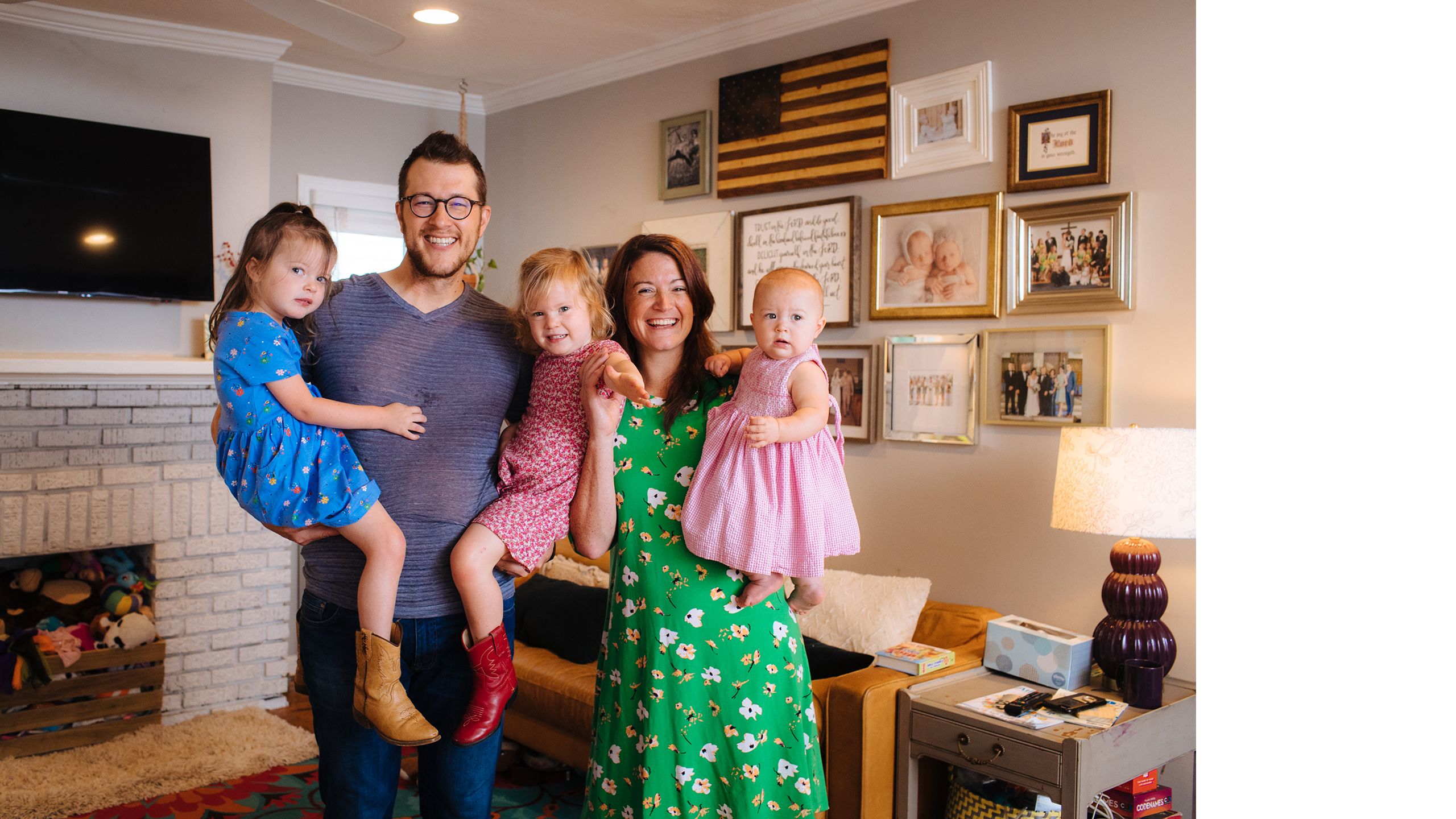

REESE enjoys her time in the spotlight.
REESE enjoys her time in the spotlight.

ADA plays peek-a-boo with the photographer.
ADA plays peek-a-boo with the photographer.
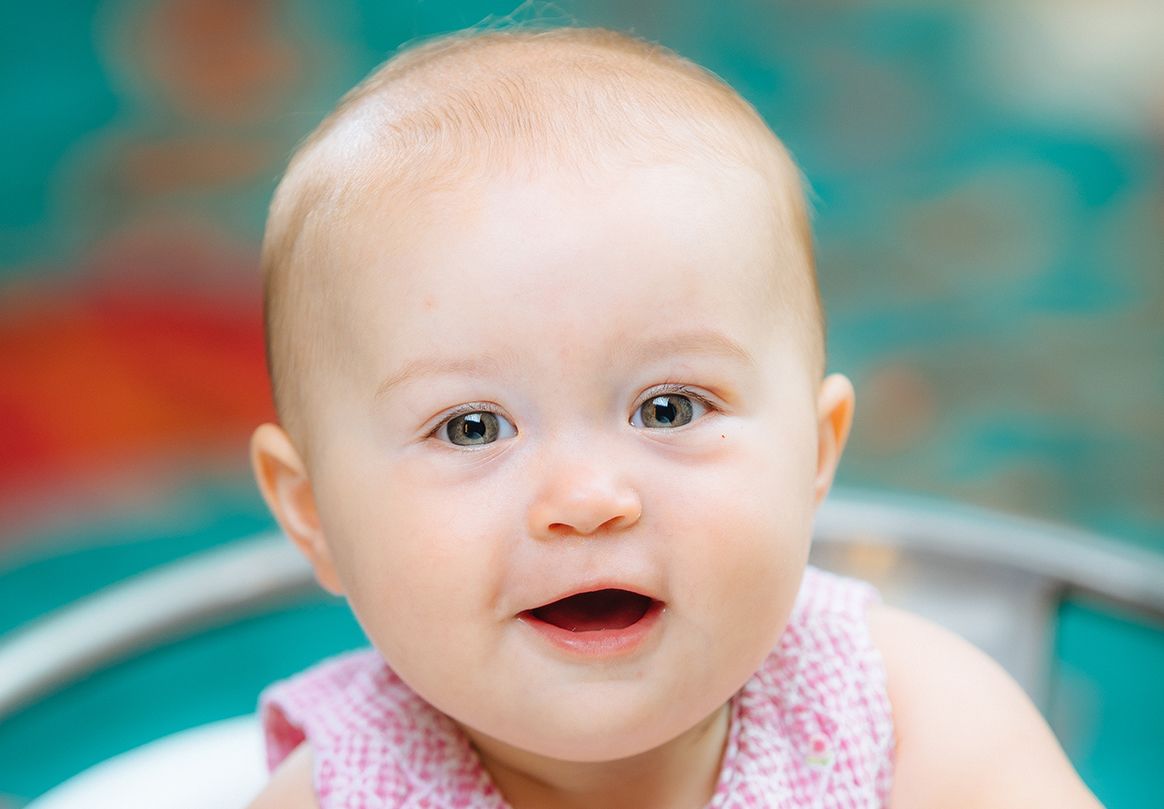
MARIAN shares a sweet smile.
MARIAN shares a sweet smile.

Kristen Christensen 14N used to hate Mother’s Day. She would go on a long run to pound out her frustrations on the pavement while all her friends, it seemed, celebrated the holiday with their babies and toddlers. Kristen and her husband, Collin, had been trying to have a baby since they married in 2006, but the pregnancy tests never came back positive. The worst part was they had no idea why. They were in their twenties, healthy, and neither knew of any reason that would keep them from conceiving. After six frustrating years, including visits to reproductive specialists, the couple decided to leave northern Virginia and move to Atlanta. “It was so hard watching all of our friends have babies, we just felt like we needed a fresh start,” says Kristen. “So we came to a new city and took a little time off from all the reproductive stress.”
Kristen enrolled in Emory’s Nell Hodgson Woodruff School of Nursing, earning a BSN in 2014. She now works in the cardiac ICU at Children’s Healthcare of Atlanta. Collin started doing carpentry work, which he built into a thriving custom woodworking business. In 2015, they decided they were ready to try again to start a family.
Kristen found a website that ranked fertility clinics by success rates, and the Emory Reproductive Center (ERC) topped the list of Atlanta facilities, so they decided to start there. Once the couple met with the center’s medical director, Jennifer Kawwass, they knew they had found the right place. It wasn’t just that Kawwass spent several hours with them reviewing all their past records and discussing options. And it wasn’t just that she showed them the studies and data that backed up her recommendations. It was that Kawwass listened as well as she talked.
WE CAN PROVIDE THE MEDICAL FACTS, BUT A HUGE PART OF THE EQUATION IS EMOTIONAL. IT'S UP TO EACH COUPLE TO DECIDE WHAT IS BEST FOR THEM, AND WE WORK FROM THERE.
—Jennifer Kawwass
“We have the utmost respect for this science, but you can get out of control with it and create thirty or more embryos,” says Kristen. “We wanted Dr. Kawwass to know from the beginning that we considered every embryo to be a life, to be our child, so we didn’t want dozens of them. She respected and worked with our faith.”

REESE enjoys her time in the spotlight.
For Kawwass, that’s part of the job. “Our role is partly as educators, to lay out the options and the chances of success,” she says. “We can provide the medical facts, but a huge part of the equation is emotional. It’s up to each couple to decide what is best for them, and we work from there.”

ADA plays peek-a-boo with the photographer.
The Christensens went through one in vitro fertilization (IVF) cycle that yielded five embryos. They implanted two and froze three. Thirty-seven weeks later, they welcomed twin girls, Ada and Reese. A couple of years later, they thawed the three embryos; one became their daughter Miriam.

MARIAN shares a sweet smile.
As a mother of three young children, “I’m exhausted at the end of every day, and it’s often hard to get out of bed in the morning,” Kristen says. “But my husband and I get to see our faces in them, and that was something I wasn’t sure we’d ever get.” She still takes a long run on Mother’s Day. But she spends the rest of the day with her own baby and toddlers.
How Some Babies Are Made
The Christensens were among the thousand new patients treated by ERC each year. Located on a top floor of Emory University Hospital Midtown, the practice is home to five reproductive endocrinologists who are also on the faculty of Emory School of Medicine, a team of embryologists, a urologist, nurses, and staff.
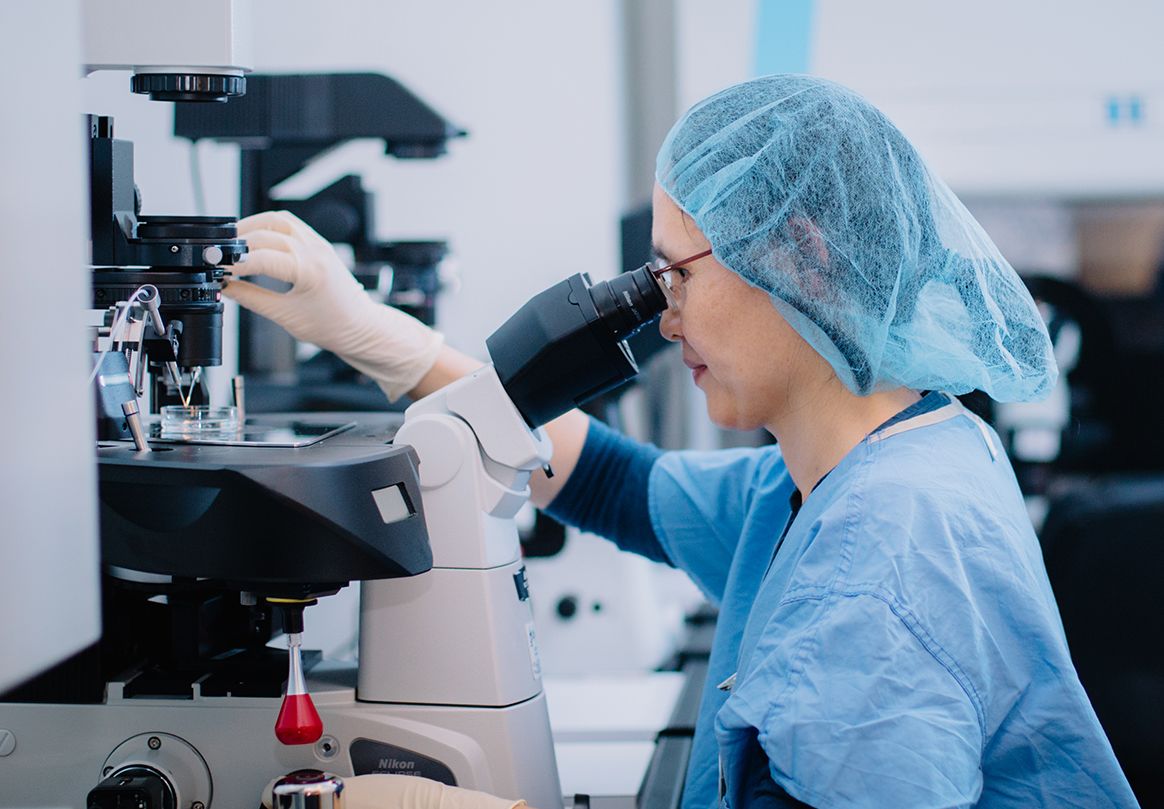
BEHIND THE SCENES Weitao Sun, one of ERC’s embryologists, uses a delicate micromanipulator to perform sperm injections, assisted hatching, and embryo biopsies for genetic testing.
“We are committed to providing care that is founded in scientific evidence of benefit” says Kawwass. “It can be tempting to try something new or en vogue that may not yet have proven safety or efficacy. Our physicians are also academics. We stay abreast of a rapidly evolving field while basing our treatments on sound, evidence-based data. Our affiliation with Emory University also means we train fellows in our practice, so we are surrounded by smart people asking tough questions. That keeps us driven to be able to provide sound, scientific answers as to why we do what we do.”

FAMILY CHAMPIONS Jennifer Kawwass (left) and Jessica Spencer (right) make wishes come true for people who want children but are unable to conceive.
FAMILY CHAMPIONS Jennifer Kawwass (left) and Jessica Spencer (right) make wishes come true for people who want children but are unable to conceive.
For most patients, the first step of the journey is a round of tests to see if the cause of infertility can be identified. About 30 percent of infertility is caused by female reproductive problems, such as endometriosis, polycystic ovary syndrome, fibroids, or age. Another 30 percent is male related, such as low sperm count or low sperm motility. The remaining 40 percent is a combination of male and female related factors or unexplained.
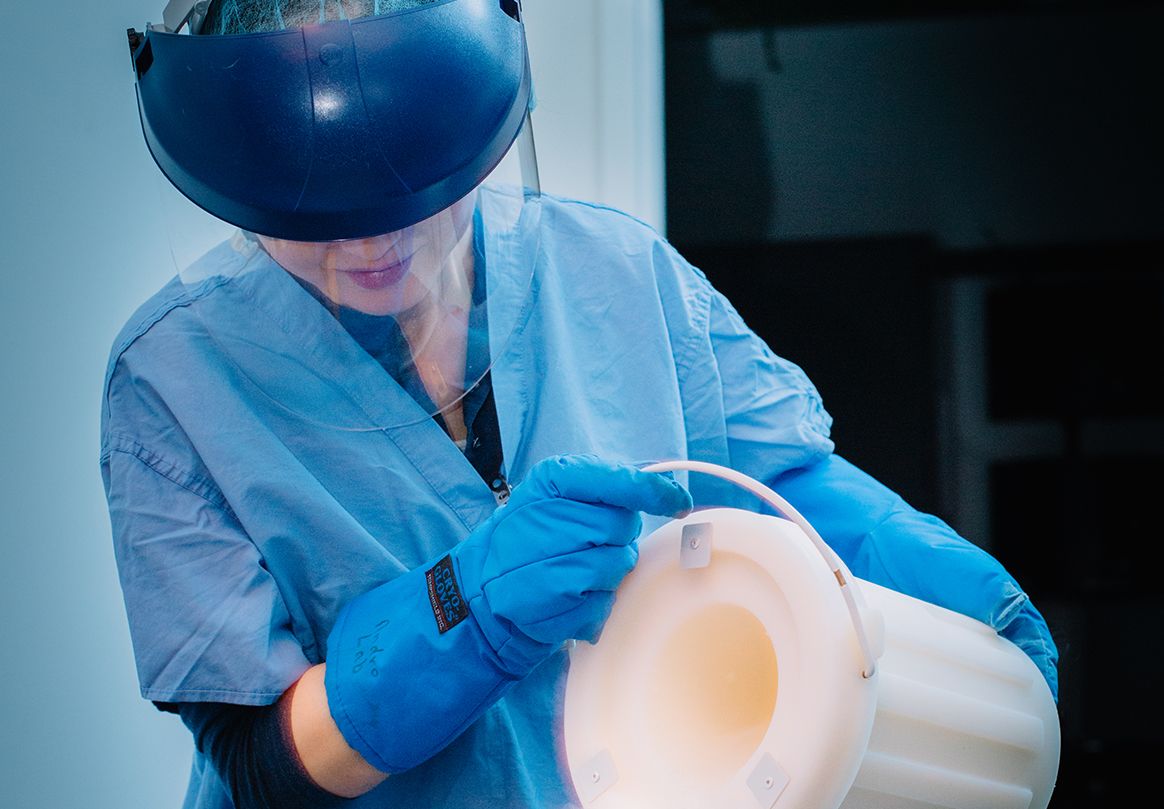
PRESERVATION Liquid nitrogen tanks are charged weekly to preserve eggs, embryos, and sperm.
Many of ERC’s patients start by trying intrauterine insemination (IUI)—depositing the male’s sperm via catheter directly into the woman’s uterus at the time of ovulation. The procedure has two main drawbacks— the chance of pregnancy is typically not more than 15 percent per attempt and, since many women take medications to stimulate egg production, the risk of having twins, triplets, or more is elevated. But compared with IVF, IUI is much less expensive and less physically burdensome on the female.

The Emory Reproductive Center physician team, l-r: Jennifer Kawwass, Jessica Spencer, D. Austin Schirmer, James Toner, Heather Hipp
The Emory Reproductive Center physician team, l-r: Jennifer Kawwass, Jessica Spencer, D. Austin Schirmer, James Toner, Heather Hipp
“Unless the woman has a problem with her fallopian tubes or the man has an extremely low sperm count, many couples will try one to three cycles of IUI before moving on to IVF or other options, such as adoption,” says Jessica Spencer, division director of Reproductive Endocrinology and Infertility at Emory School of Medicine.
If IUI doesn’t result in conception, many couples can—and do—chose IVF. Since the birth of the first “test-tube baby” in 1978, the procedure has exploded. Now more than 250,000 IVF cycles are performed each year, and they are responsible for 8 percent of all live births in the US.
Several advances have made IVF safer and more effective. New medications and protocols have greatly reduced the risk of ovarian hyperstimulation syndrome, one of the more serious potential complications of fertility treatments which now occurs in less than 1.5 percent of all cycles. Embryologists can now grow embryos longer in culture, increasing their likelihood of implantation.
“We used to grow embryos two to three days and then implant or freeze them at the cleavage stage, which is when they are eight cells,” says Kawwass. “Now we can grow them for five or six days to the blastocyst stage, when they are about one hundred cells. Likelihood of implantation is much higher for a single blastocyst embryo compared to a single cleavage embryo.”
Couples can elect to do genetic testing on the embryos, particularly if either carries an inheritable disease. “We offer genetic carrier screening before treatment,” says Spencer. “This helps to identify couples that may be at risk of having a child with a rare genetic disease. It’s also important for women to consider before choosing a donor.”
One such test is JScreen, a nonprofit genetic screening organization based at Emory.
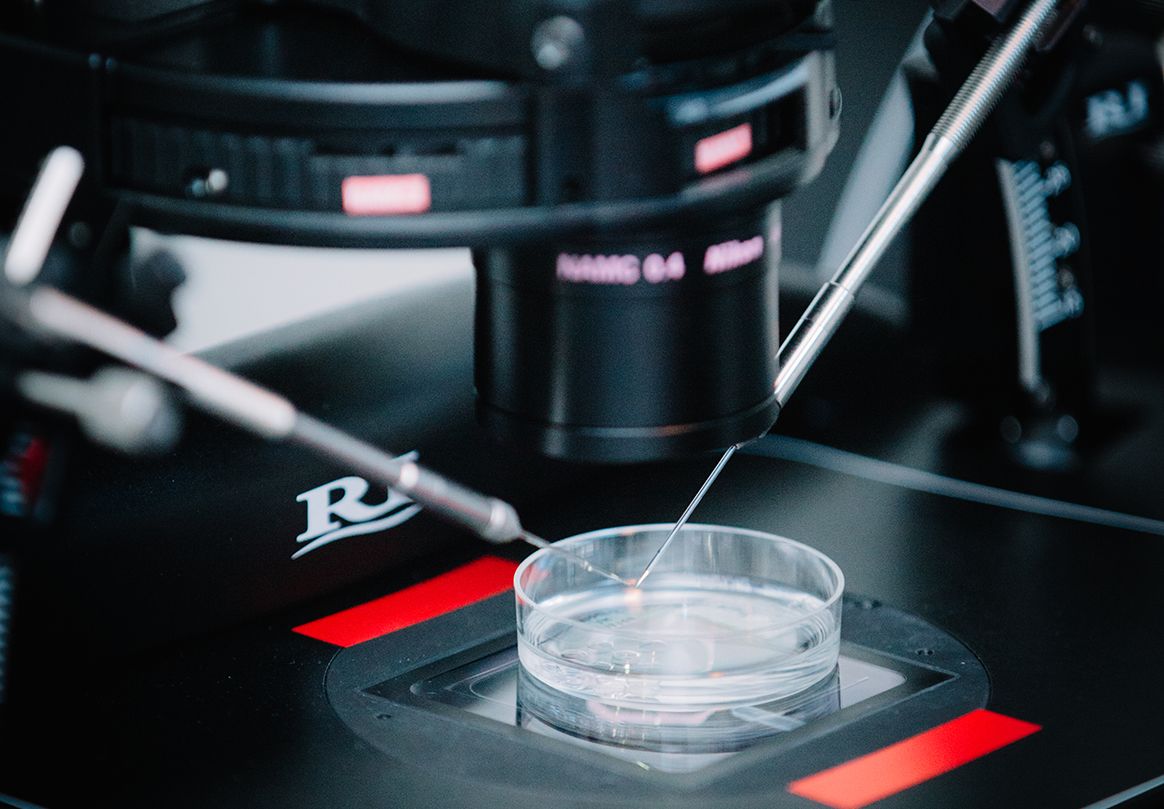
CLOSE UP Micromanipulators allow embryologists to make fine movements under the microscope.
Embryos are graded by their appearance—symmetry, percent cell degradation—with As being outstanding, Bs being good, and so forth. The best quality embryos are transferred first. In certain individuals, a technique called assisted hatching can improve the chance of an embryo sticking to the uterine wall.
These advances have boosted the success rate per IVF cycle in women under 35 percent to around 50 percent, which has promoted the practice of transferring just one embryo. In the 1980s and 1990s, doctors routinely implanted four embryos per cycle, resulting in an explosion of multiple births. Almost half of successful IVF cycles resulted in twins. A smaller but still significant number of cycles produced triplets or quintuplets.
Multiple births create related problems for mothers and babies. Carrying more than one child increases a woman’s risk of gestational high blood pressure, gestational diabetes, anemia, and miscarriage.
Sharing the womb increases the risk for premature birth, low birth weight, and birth defects for the infants. “Perhaps the biggest breakthrough in IVF is that we’ve been able to continue the success rates of the past ten years, but have dropped multiple gestation rates dramatically,” says Kawwass. “Nationwide, the focus has shifted from getting a woman pregnant as quickly as possible to getting the healthiest outcome at the end of pregnancy, with a full-term birth at normal birth weight.”
Since an IVF cycle typically produces several embryos, many couples choose to freeze some for future attempts.

BEHIND THE SCENES Weitao Sun, one of ERC’s embryologists, uses a delicate micromanipulator to perform sperm injections, assisted hatching, and embryo biopsies for genetic testing.
BEHIND THE SCENES Weitao Sun, one of ERC’s embryologists, uses a delicate micromanipulator to perform sperm injections, assisted hatching, and embryo biopsies for genetic testing.

PRESERVATION Liquid nitrogen tanks are charged weekly to preserve eggs, embryos, and sperm.
PRESERVATION Liquid nitrogen tanks are charged weekly to preserve eggs, embryos, and sperm.

CLOSE UP Micromanipulators allow embryologists to make fine movements under the microscope.
CLOSE UP Micromanipulators allow embryologists to make fine movements under the microscope.

When the Clock Starts Ticking
Since 2013, women have had another option to preserve their fertility—freezing their eggs. Reproductive endocrinologists have been able to freeze sperm and embryos for decades, but eggs are more delicate. An advance in freezing technology allows for eggs to be flash frozen, better preserving them.
Women may choose to preserve their eggs before undergoing chemotherapy, hysterectomy, or gender transition. The lion’s share of egg freezing, however, is done by women who are simply not ready to have a baby. Perhaps they haven’t married yet. Or maybe they are in graduate school. Or they want to wait until they are in a better financial situation.
For these women, egg-freezing offers the potential to defy the ticking clock. “It’s the age of the egg that drives the chance of pregnancy, not the age of the uterus,” says Kawwass. “When you freeze your eggs, they stop aging. So if you freeze your eggs at twenty-nine, and then thaw and use them at thirty-nine, you have the same chance of a successful pregnancy as a twenty-nine-year-old.”
That’s why Caroline Osborne decided to freeze her eggs in early 2018. She was thirty-four at the time, not in a relationship, and knew she wanted to have children eventually. She was happy to learn that her health insurance through Coca-Cola North America, where she works as a director in revenue-growth management, covered most of the procedure.
She Googled egg-freezing in Atlanta, and the first article to pop up was written by Kawwass. After meeting with her to discuss the procedure, she decided to go forward. “After my eggs were frozen, I felt this great sense of empowerment,” she says. “I felt confident to live my life how I wanted to live it without the pressure of worrying about missing the window of starting a family.”
Osborne is now engaged and planning an April 2020 wedding. They plan to start trying to have a baby shortly afterward, but Osborne feels good knowing she has the possibility of trying IVF with her frozen eggs if that doesn’t work out.

Frank and Patrice distract Emerson with a balloon.
Frank and Patrice distract Emerson with a balloon.
Patrice Basanta-Henry decided to freeze her eggs at thirty-eight. A maternal fetal medicine specialist, Patrice was divorced with no children and not in a relationship, but she knew she wanted to be a mom. As luck would have it, she met her future husband, Frank Ski, just as she was preparing to harvest her eggs for freezing. Frank, a popular Atlanta morning radio personality, had four grown children from a previous marriage, but he understood how important having a baby was to Patrice, so he agreed to go on the journey—a long and costly one.
Patrice produced fifteen eggs to freeze. When they were thawed and fertilized with Frank’s sperm, six embryos survived. Due to Patrice’s age, they opted for genetic testing, and only one of the embryos tested normal. “I went from the high of having fifteen eggs to the low of having only one embryo,” she says. “I was devastated.”
Being an ob/gyn, Patrice was schooled in the intricacies, risks, and tradeoffs of fertility treatments, and she told Kawwass she wanted to be as aggressive as possible, always making sure some embryos were frozen even as she went through more retrieval cycles. “I always wanted to have the insurance policy of having some frozen embryos for the next try,” she says. “Dr. Kawwass understood and respected my wishes.”
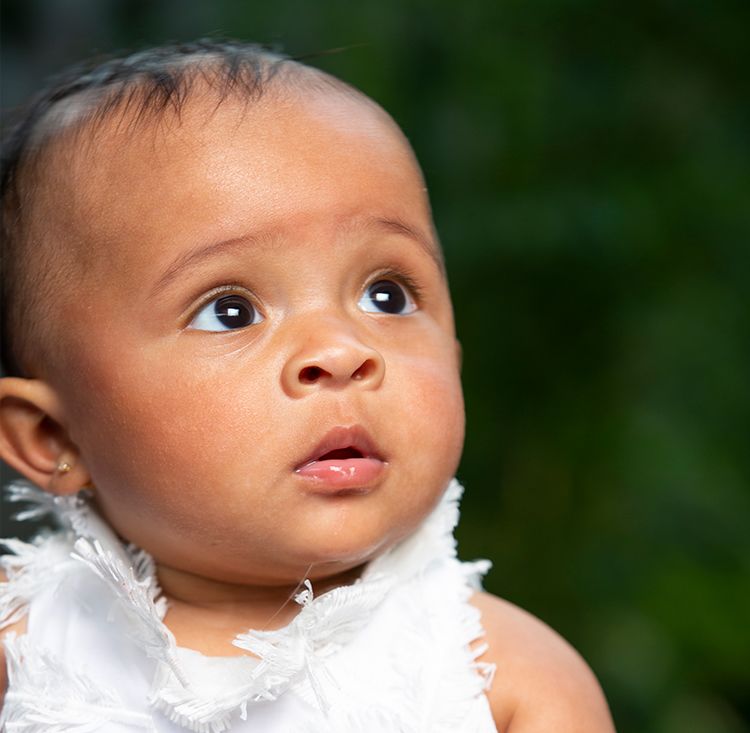
EMERSON is fascinated by the photographer's bright lights.
In the end, Patrice went through four unsuccessful IVF cycles, but on the fifth cycle, one little fighter survived. Emerson was born on March 2, 2019.
Though the cost, both emotional and financial, was great, Frank and Patrice agree that being parents to Emerson is priceless.
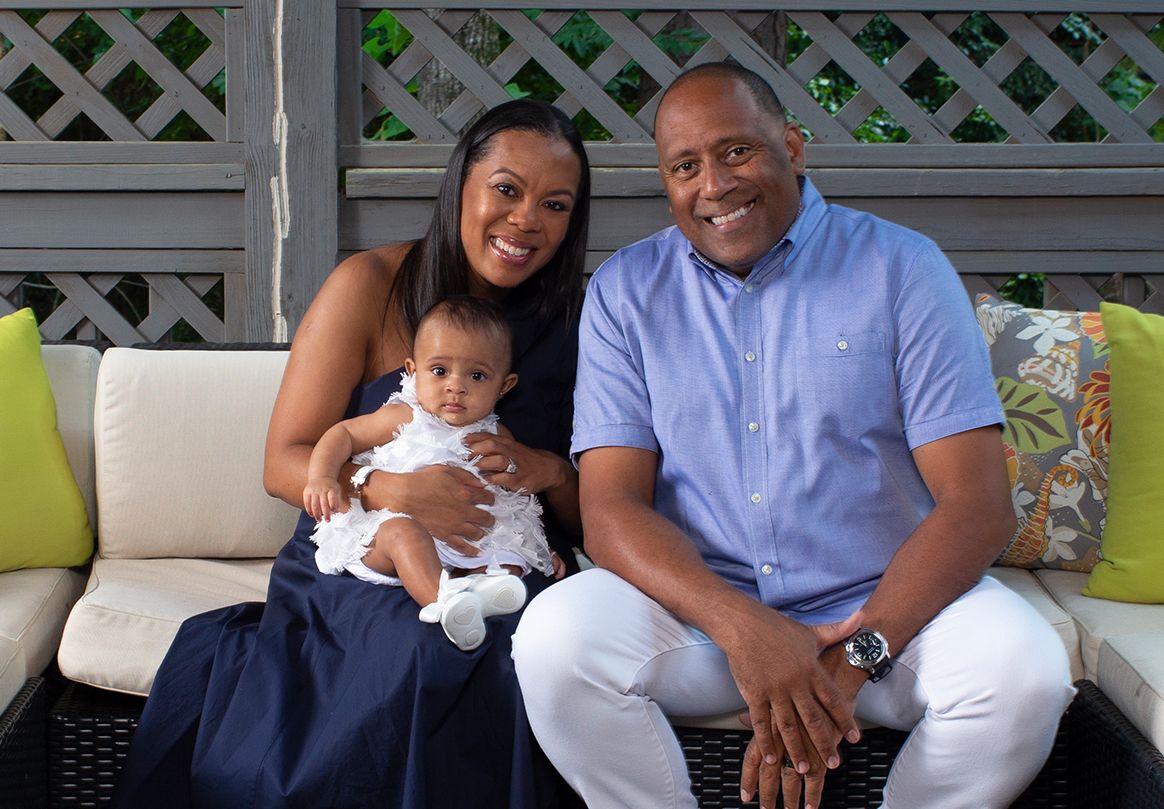
PRICELESS Patrice Basanta-Henry and Frank Ski welcomed their daughter, Emerson, in March. The road to get her was emotionally and financially steep, but the path ahead is filled with hope.
“Everyone at Emory was so caring and supportive through the whole process,” she says. “My nurse, in particular, understood how hard it was for me to take care of pregnant women all day and not be able to get pregnant myself. The whole team kept checking up on me, even after Emerson was born.”

EMERSON is fascinated by the photographer's bright lights.
EMERSON is fascinated by the photographer's bright lights.

PRICELESS Patrice Basanta-Henry and Frank Ski welcomed their daughter, Emerson, in March. The road to get her was emotionally and financially steep, but the path ahead is filled with hope.
PRICELESS Patrice Basanta-Henry and Frank Ski welcomed their daughter, Emerson, in March. The road to get her was emotionally and financially steep, but the path ahead is filled with hope.

Helping Same-Sex Couples
ERC offers a host of other family building options. The center offers egg donation, sperm donation, embryo donation, and gestational surrogacy. These alternatives can be especially helpful for would-be parents in the LGBTQ community.
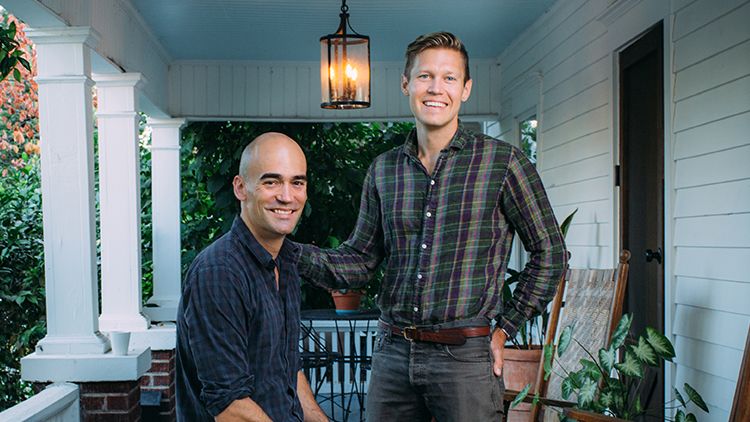
IT'S A GIRL! With the help of an egg donor and a surrogate, Ty and Matt Moddelmog are expecting a girl in November.
Ty and Matt Moddelmog both knew they wanted to have children before they even met, nine years ago in New York. “I think we actually talked about it on our second date,” says Ty.
The couple married, moved to Atlanta, and started new jobs—Matt at a start-up called Clutch Technologies and Ty at the Home Depot working on the in-store environment. When they decided they were ready to start a family last year, ERC happened to be their first stop. It became their last.
“We went in and met with Dr. Spencer, and she spent so much time with us,” says Matt. “She instilled an enormous amount of confidence, and she made us feel totally comfortable.”
Spencer referred the couple to a surrogate agency, which independently matched them with a surrogate. “We first met over the phone and fell hard,” says Ty. “It was clear that she herself is an amazing mother with two wonderful daughters and a loving husband—a great support network to help us through a really important time in all of our lives. We love joining her for doctor’s appointments and even get together socially.”

The proud fathers-to-be show off an image of their embryo.
The proud fathers-to-be show off an image of their embryo.
ERC joined the donor’s eggs with Ty’s sperm to produce several embryos, one of which was transferred to the surrogate, who is due to deliver their daughter in mid-November. Ty and Matt plan to head back to ERC soon afterward to try for a second baby.

IT'S A GIRL! With the help of an egg donor and a surrogate, Ty and Matt Moddelmog are expecting a girl in November.
IT'S A GIRL! With the help of an egg donor and a surrogate, Ty and Matt Moddelmog are expecting a girl in November.
‘Six Years of Our Lives’
The expertise and personalized focus of ERC is perhaps most useful in the most difficult cases.
“Throughout the IVF process, we make day-to-day decisions based on how the body responds to treatment and based on the underlying factors contributing to infertility,” says Kawwass. “These decisions include things like adjustment of medication doses, timing of trigger [release of the eggs], timing of transfer, number of embryos to transfer, use of preimplantation genetic testing, and much more. The beauty of ERC is that the physicians work as a team to develop a plan that incorporates the patient’s personal priorities and also their individualized medical response to treatment, which may evolve over the course of an IVF cycle. There is a true ‘art’ to fertility treatment—there is not one clear path. The decision of how to proceed involves a very detailed approach to consider the pros and cons of each intervention and next step for an individual patient.”
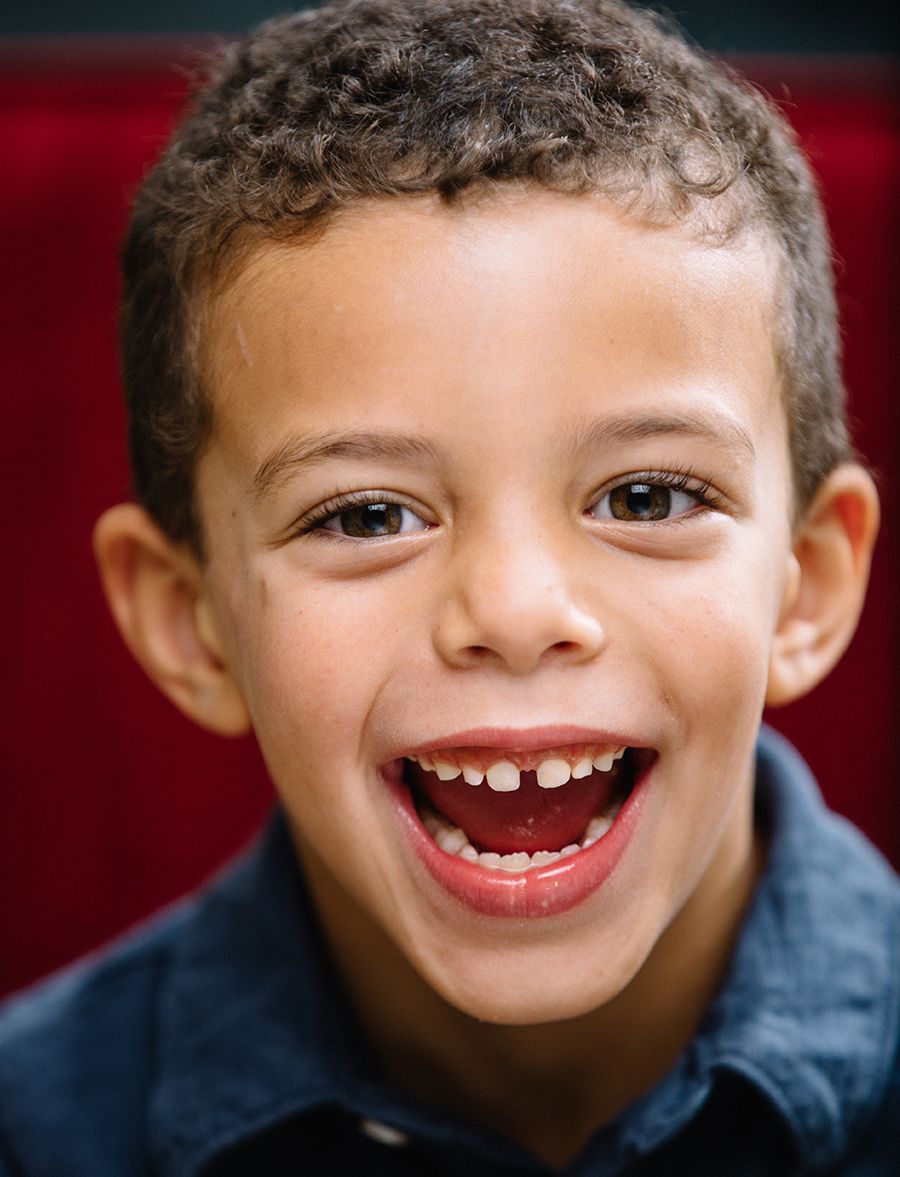
ETHAN is a high-energy, curious boy.
Korynn Schooley and Jared Serwer decided to go to an Atlanta fertility clinic after Korynn had two miscarriages in the same year. Two unsuccessful IUI cycles led to more heartbreak and frustration with a process they felt was impersonal and rushed. So Korynn and Jared came to ERC for a second opinion.
“Dr. Spencer spent so much time with us during our first meeting,” says Korynn. “She had already read our chart before we got there and knew our entire history. She was ready with research. She explained how things worked and the likelihood of different methods being successful. She said she thought we had a decent chance.”
THIS WAS OUR HAIL MARY. THIS WAS GOING TO BE OUR LAST ATTEMPT BEFORE WE TURNED TO DONOR EGGS OR ADOPTION.
—Korynn Schooley
Spencer started Korynn on an IVF regimen with a different protocol. The regimen leading up to egg retrieval was intense. Korynn needed two injections of fertility medications a day plus another injection to potentially help prevent miscarriages. In the beginning, she wasn’t able to give them to herself, so the job fell to Jared. First, the medications for each cycle would arrive via FedEx on dry ice. For each injection, Jared retrieved six vials of different medications from the basement refrigerator, drew the contents of the first vial into a syringe, injected it into the second, let it mix, drew it back up in the syringe and then repeated the process down the line until he had mixed the correct cocktail.
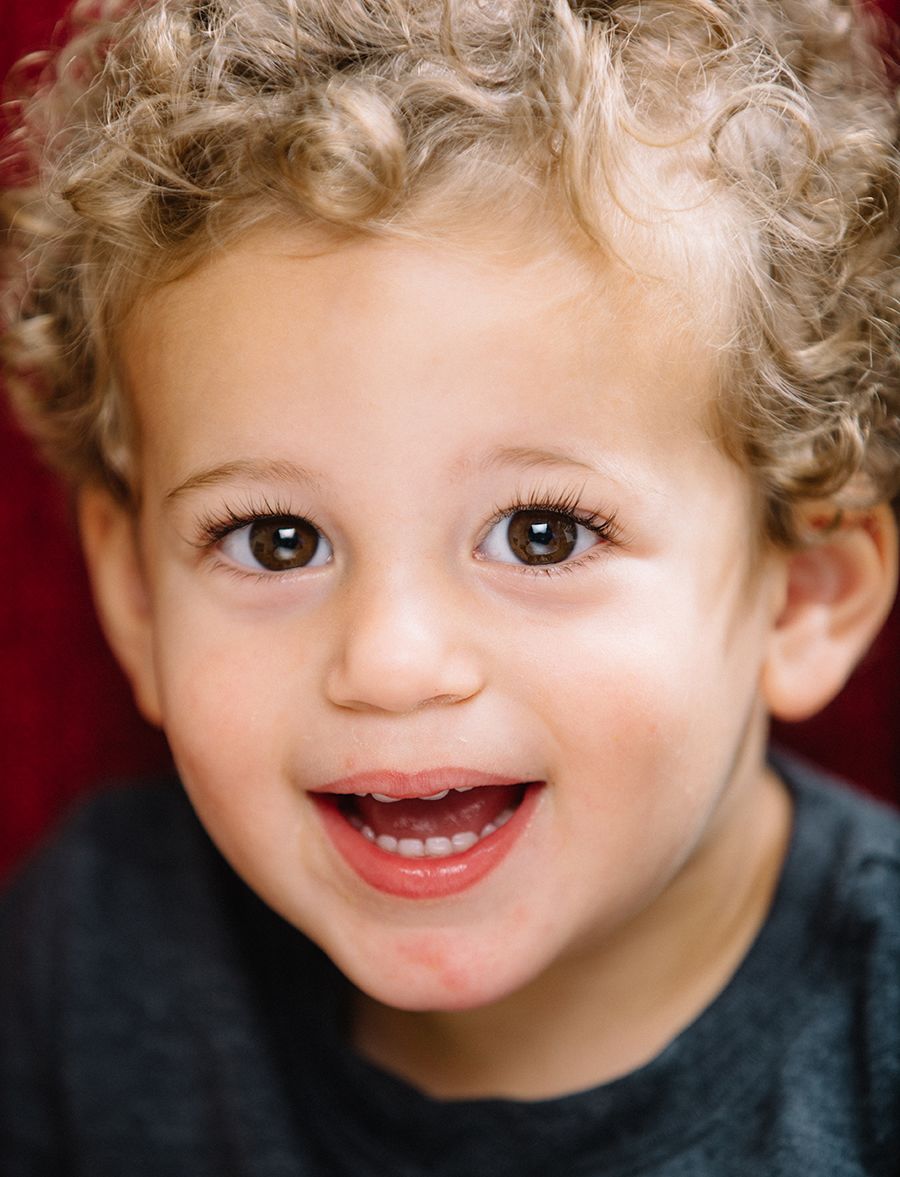
CALEB loves to follow his older brother around.
“The shots had to be given within a specific window of time,” says Jared. “Mornings and evenings were no problem, but at midday I’d drive from my midtown office to her south Atlanta office, draw up all the medications, give her the shot, and drive back. Every day.”
Despite all the effort, Korynn’s first IVF cycle was not successful. Korynn was expecting a similar result after her second IVF cycle, so she took the day off work. But the office called with good news. She was pregnant.
After an uneventful pregnancy, Korynn and Jared welcomed Ethan on November 6, 2013.
The couple was quickly back at ERC to try for a second child. After multiple cycles with two pregnancies, both ending in miscarriages, they decided to try a new approach.
Korynn was now forty, so she started to bank embryos. She went through three back-to-back egg retrievals, which ultimately resulted in twelve embryos.
This time they decided to have them genetically tested. Only one came back normal, and it was given a low grade. After talking through the pros and cons with ERC, they implanted it anyway, but Korynn did not get pregnant.
Devastated, the couple decided to try one last time.
“This was our Hail Mary,” says Korynn. “This was going to be our last attempt before we turned to donor eggs or adoption.”
Spencer decided to dial back the measures they had been using to see if Korynn’s body would respond better to minimal stimulation. Korynn took a lower dose and started taking her medications later in the cycle. Spencer and the Emory team made adjustments along the way as they monitored Korynn’s response.
Shortly after the transfer, the couple flew to Washington, D.C., to celebrate Jared’s mother’s birthday. When they got off the plane in Washington National, Korynn’s phone rang.
“All of the nurses from the office were on the call, and they just screamed, ‘You’re pregnant! Congratulations!’ ” she says.
Caleb was born May 9, 2017. Ethan and Caleb are great buddies, and Korynn and Jared are enjoying their boys every day.

WORTH THE WAIT Jared Serwer and Korynn Schooley went through multiple rounds of IVF over six years to get their sons, Ethan (age 5) and Caleb (age 2). Today their lives are rough and tumble and joyous.
WORTH THE WAIT Jared Serwer and Korynn Schooley went through multiple rounds of IVF over six years to get their sons, Ethan (age 5) and Caleb (age 2). Today their lives are rough and tumble and joyous.
“Six years of our lives were given over to this process,” says Korynn. “I feel like the only reason we have children is because of Emory. If we had to go through this very difficult process, at least it was with them.”
By Martha McKenzie// Photography Ann Watson and Stephen Nowland //Design Elizabeth Hautau Karp

ETHAN is a high-energy, curious boy.
ETHAN is a high-energy, curious boy.

CALEB loves to follow his older brother around.
CALEB loves to follow his older brother around.
Want to know more?
Please visit Emory Magazine, Emory News Center, and Emory University.


